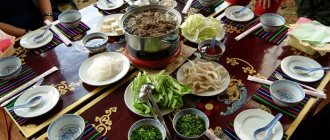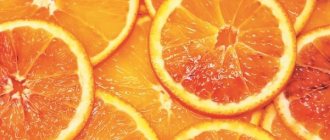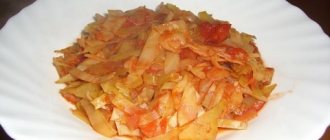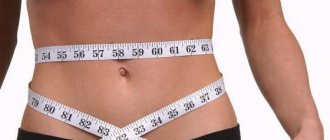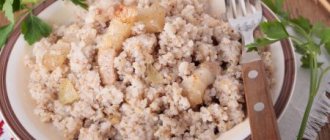Everything that comes to us from Tibet is useful by default. Let's find out if this applies to diet.
The Tibetan diet promotes weight loss, rejuvenation of the body, elimination of waste and toxins, acceleration of metabolism, increased ability to work, and endurance throughout the day.
Everyone has long known that Tibetan monks live quite a long time and at the same time lead a modest, restrained lifestyle. They achieve longevity thanks to a special diet, balance of nutrients, and mental balance.
Diet
The monks' diet is based on a complete ban on meat and meat products. The daily menu consists of plant and dairy foods, which is why the diet is called lacto-vegetarian (or lacto-vegetarian), although fish is also allowed.
Proper nutrition consists not only in the selection of foods, but also in the procedure for eating. There are rules that are recommended to be followed to ensure that food brings more health benefits:
- Eat slowly and chew food thoroughly. To avoid a feeling of heaviness in the stomach, you should eat in small portions, about 200 grams per meal. Snacks are prohibited.
- Drink more mineral still water.
- Eat fresh foods.
- The most optimal preparation is steamed, you can stew, bake, but do not fry.
- Do breathing exercises and physical exercises.
- Don't eat right before bed.
Advice! It’s good to create a pleasant environment during a meal - turn on meditative music, it creates harmony in the soul and promotes proper nutrition.
Tibetan cuisine
A person who, at least once, tried the food of Tibetan monks would be delighted with the unique taste of their dishes. And I would be pleasantly surprised that many of our familiar products are tabooed. Tibetans, for example, do not eat seafood and some fruits. But let’s not go into the intricacies of Tibetan cuisine; their secrets will have to be revealed for many millennia if they themselves do not open the curtain.
In what cases do they resort to the Tibetan diet?
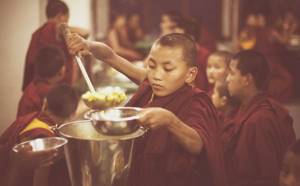
The diet of Tibetan monks, when properly combined with walks in the fresh air, adherence to sleep and rest, and meditation, helps well with many diseases, as well as for improving the general condition of the body:
- increases immunity;
- improves mental state;
- promotes good sleep;
- the nervous system is strengthened;
- the body is cleansed.
Another important property of the diet of Tibetan monks is that it helps fight excess weight. It is known that excess weight not only spoils the figure, but also negatively affects the functioning of all internal organs - there is a risk of developing diabetes mellitus, Alzheimer's disease, problems with the heart and blood vessels, and depression occurs. A person seeks to get rid of such a “bouquet” and the effective diet of the monks of Tibet will help him with this.
Results: weight can be reduced by 4-5 kg in a week, while digestion improves, the body is cleansed, metabolism accelerates, and other changes for the better occur.
Summary
To bring yourself at least a little closer to the life of Tibetan monks, you can try a diet based on their nutritional principles. Drinking plenty of water and eating the right foods help cleanse the body and help you lose extra pounds.
Reader’s story “How I lost 18 kg in 2.5 months” I’ve been fat all my life and suffered from excess weight. In clothing stores I chose size L, which by the age of 25 turned into XL and continued to grow. I can tell you for a long time how I tried to fight my 30-35 extra pounds: diets, hunger strike, physical activity, even pills and some kind of conspiracies. The effect was short-lived or absent altogether. In short, despair, depression and almost resignation to one’s enormous weight. But one day I came across... a chocolate bar that helps you lose weight! It didn’t cost me anything to try it - I love chocolates. I ordered it and ate it. And the weight crept down!! It seems like mysticism, but it's true. I began to study the issue and realized how it all works. Girls, try it! I have already lost 18 kg in 2.5 months. And I continue. It's up to you, but you don't lose anything except weight, of course. Try Choco Burn chocolate for weight loss for 147 rubles.
What are the pros and are there any cons?
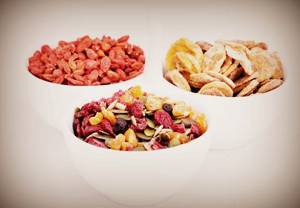
Healthy nutrition has, according to scientists, a significant number of positive aspects:
- the body becomes younger - the face becomes fresh, the figure becomes toned, the person feels ease of movement;
- there is no need to starve - the diet is quite sufficient for adequate nutrition;
- minimum financial budget - products are the most affordable;
- easy to comply with, has few prohibitions;
- effectiveness - you can get rid of up to 5 kg in a week;
- metabolism is normalized;
Disadvantages: you will have to prepare food daily, fast food and semi-finished products are prohibited; you need to give up your favorite drinks, cigarettes and alcohol; It is forbidden to eat meat, and some people find it difficult to refuse.
Menu for seven days
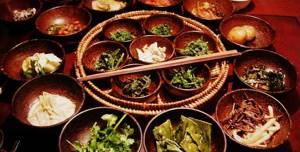
Remember! Despite all its usefulness, Russian nutritionists do not recommend following the diet for more than a week when first used.
After familiarizing yourself with the basic principle of the diet, you can easily create it yourself. Portions should be 200-250 g.
| First day |
|
| Second day |
|
| The third day |
|
| Fourth day |
|
| Fifth day |
|
| Sixth day |
|
| Seventh day |
|
The diet is balanced, it is well tolerated, and therefore has almost no contraindications.
Authorized Products
If you study the proposed menu for the week, you will see that the monks’ diet is based on vegetables, fruits, juices, milk, fish and crackers. The choice of each of these components of the diet must be taken very responsibly:
- vegetables that contain the maximum amount of minerals and trace elements, grown without fertilizers or exposure to other artificial factors;
- treat yourself to fruits , the menu includes apples and fruit salads almost every day, treat yourself to exotic mangoes, avocados, carambola, pitahaya, try something new;
- Juices should be highlighted as a separate item ; the menu often includes tomato and apple juices as a third item, so during the diet you need to borrow or buy a not very powerful juicer, which will be enough to squeeze a glass of juice from juicy fruits;
- Drinking milk in the morning is a rule that in everyday life will give you an excellent boost of energy, saturate your body with healthy fats , vitamins , calcium and other macro- and microelements, in addition, you can replace milk with your own prepared milk on the 5-6th day yogurt prepared with the addition of starter into milk;
- portions of boiled fish should be moderate - no more than 200 g, not contain a lot of salt, and it is advisable to take fillets that have not been frozen;
- crackers are a unique product, they are very pleasant to eat with tea and they have special healing properties, unlike fresh bread, they normalize the functioning of the gastrointestinal tract, eliminate the effects of intoxication and are lower in calories; Of course, it’s better to cook them yourself - take whole grain or rye bread and dry it in the oven, and of course, don’t overuse it - 1-2 no more!
Table of permitted products
| Proteins, g | Fats, g | Carbohydrates, g | Calories, kcal | |
Vegetables and greens | ||||
| eggplant | 1,2 | 0,1 | 4,5 | 24 |
| fried zucchini | 1,1 | 6,0 | 6,7 | 88 |
| cabbage | 1,8 | 0,1 | 4,7 | 27 |
| bulb onions | 1,4 | 0,0 | 10,4 | 41 |
| carrot | 1,3 | 0,1 | 6,9 | 32 |
| cucumbers | 0,8 | 0,1 | 2,8 | 15 |
| salad pepper | 1,3 | 0,0 | 5,3 | 27 |
| beet | 1,5 | 0,1 | 8,8 | 40 |
| asparagus | 1,9 | 0,1 | 3,1 | 20 |
| tomatoes | 0,6 | 0,2 | 4,2 | 20 |
| beans | 7,8 | 0,5 | 21,5 | 123 |
| zucchini | 1,5 | 0,2 | 3,0 | 16 |
| garlic | 6,5 | 0,5 | 29,9 | 143 |
Fruits | ||||
| avocado | 2,0 | 20,0 | 7,4 | 208 |
| pineapples | 0,4 | 0,2 | 10,6 | 49 |
| grapefruit | 0,7 | 0,2 | 6,5 | 29 |
| carambola | 1,0 | 0,0 | 7,0 | 31 |
| mango | 0,5 | 0,3 | 11,5 | 67 |
| papaya | 0,6 | 0,1 | 9,2 | 48 |
| peaches | 0,9 | 0,1 | 11,3 | 46 |
| feijoa | 1,0 | 1,0 | 11,0 | 49 |
| apples | 0,4 | 0,4 | 9,8 | 47 |
Cereals and porridges | ||||
| white boiled rice | 2,2 | 0,5 | 24,9 | 116 |
| boiled wild rice | 4,0 | 0,3 | 21,1 | 100 |
| boiled brown rice | 2,6 | 0,9 | 22,8 | 110 |
| unpolished red rice | 10,5 | 2,5 | 70,5 | 362 |
| rice porridge with water | 1,5 | 0,1 | 17,4 | 78 |
Bakery products | ||||
| rye bread | 11,0 | 2,7 | 58,0 | 310 |
| whole grain bread | 10,1 | 2,3 | 57,1 | 295 |
Confectionery | ||||
| crackers for tea | 10,0 | 2,3 | 73,8 | 397 |
| crackers with raisins | 8,4 | 4,9 | 78,5 | 395 |
Dairy | ||||
| milk 1% | 3,3 | 1,0 | 4,8 | 41 |
| natural yogurt 2% | 4,3 | 2,0 | 6,2 | 60 |
Cheeses and cottage cheese | ||||
| cottage cheese 0.6% (low fat) | 18,0 | 0,6 | 1,8 | 88 |
Fish and seafood | ||||
| salmon | 19,8 | 6,3 | 0,0 | 142 |
| boiled mackerel | 19,6 | 14,7 | — | 211 |
| boiled pike perch | 21,3 | 1,3 | — | 97 |
| boiled cod | 17,8 | 0,7 | — | 78 |
| boiled trout | 15,5 | 3,0 | — | 89 |
| boiled hake | 18,5 | 2,3 | 0,0 | 95 |
Oils and fats | ||||
| vegetable oil | 0,0 | 99,0 | 0,0 | 899 |
| corn oil | 0,0 | 99,9 | 0,0 | 899 |
| sesame oil | 0,0 | 99,9 | 0,0 | 899 |
| linseed oil | 0,0 | 99,8 | 0,0 | 898 |
Non-alcoholic drinks | ||||
| mineral water | 0,0 | 0,0 | 0,0 | — |
| green tea | 0,0 | 0,0 | 0,0 | — |
| dry milk tea oolong (oolong) | 20,1 | 5,1 | 4,0 | 140 |
Juices and compotes | ||||
| Orange juice | 0,9 | 0,2 | 8,1 | 36 |
| lemon juice | 0,9 | 0,1 | 3,0 | 16 |
| tomato juice | 1,1 | 0,2 | 3,8 | 21 |
| Apple juice | 0,4 | 0,4 | 9,8 | 42 |
| * data is per 100 g of product | ||||
Milk and garlic for blood pressure

Garlic has long been used in folk medicine to treat hypertension. This is a gentle way to reduce blood pressure and improve the condition of blood vessels using natural products. There are several known methods for preparing the medicinal product.
First way:
Finely chop a few cloves of garlic and pour in hot milk, leave for 3 hours.
Application: 1 table. spoon 2-3 times a day for a week. After a few days, repeat the procedure.
Second way:
Take three cloves of garlic, pour in 120 g of milk, cook for half an hour. Strain the cooled broth, add a pinch of chicory.
Application: 1 table. 3 tablespoons of the product daily for two weeks after meals, repeat the procedure after 14 days.
Varieties
There are two options for cleansing the body by eating rice every day, which can be done from 7-10 days to one month:
- eating 1 tablespoon of rice, pre-cooked in a special way: the rice needs to be soaked for a week and washed every morning, thereby removing excess starch; the main rule of this method of cleansing is that after eating 1 spoon of rice in the morning on an empty stomach, you cannot eat or drink for 4 hours;
- in the second option, it is suggested to eat as many grains of rice as you are old, but you also cannot drink or eat for quite a long time - at least 3 hours.
Raw rice diet

The effect of eating raw rice is achieved by the absorption properties of removing salt, improving the condition of the body as a whole, as well as:
- improves metabolism;
- the skin is cleansed and becomes more youthful;
- waste and toxins are removed;
- the functioning of the gastrointestinal tract is normalized;
- swelling disappears;
- loses up to three kilograms per week.
How to cook: add water to the rice and change the water every day, rinsing the grains and adding water again. On the 6th day, this rice is poured with hot food and eaten.
The point of the diet is that cereals are consumed after 6 days of soaking, pouring a new portion of the product every day.
Our body is not accustomed to such food; in this case, you can lightly boil the product in a small amount of water.
For stomach problems, it is more effective to eat rice raw.
Directions for use: eat for breakfast, drink 250 ml of water 25 minutes before meals.
Important! After breakfast, do not drink for four hours.
Effect of diet
Doctors recommend that everyone who suffers from dysfunction of the liver, kidneys, intestines, cardiovascular system, joint diseases, is prone to edema, atherosclerosis, and is physically weakened should adhere to plant-and-milk nutrition. For this reason, the diet of Tibetan monks is considered therapeutic and health-improving.
- The absence of meat products in the diet rids the body of excess harmful uric acid and toxins.
- Cereals, vegetables and fruits are loaded with antioxidants, minerals and vitamins, prevent the development of cancer, and help maintain a healthy complexion.
- Dairy products provide the required amount of calcium. It promotes fat burning and is necessary for a complete general metabolism.
Regular dieting helps you lose 2–4 kg. excess weight per week.
It is important that even after its completion and return to the usual menu, the weight continues to disappear for some time. The reason is the acceleration of metabolic processes, normalization of liver and intestinal functions. Along with the weight, increased fatigue, irritability and anxiety gradually disappear.
You need to follow the Tibetan diet for at least 10 days. You can repeat after a 2-week break.

Tibetan diet with herbs and milk mushroom
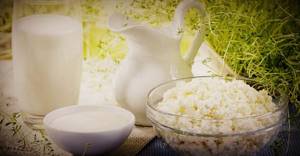
Herbal infusions help improve vision and skin condition. The duration of the procedure is one month.
To prepare a medicinal collection, you need to take 100 g of chamomile flowers, birch buds, bloodworm and goldenflower herbs and 50 g of honey herb - stevia.
Preparation: Mix the plants in equal quantities, one tablespoon at a time, and brew with boiling water. Let it brew for half an hour, strain and take morning and evening after meals.
Diets with milk mushroom:
The mushroom has unique properties: removes excess salt, fights heart disease, normalizes blood pressure, resolves benign tumors, optimizes the effect of medications, and acts as an antiallergic agent.
How to prepare: pour warm milk (250 mm) into a tablespoon of mushroom grains, leave to ferment for 24 hours, then strain.
Consume 200-250 milliliters per day. Last dose an hour before bedtime. Take for three weeks, take a break and repeat the course.
Tibetan approach to nutrition and treatment of the body
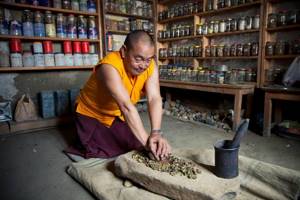
Tibetan medicine differs from other medical traditions of Asia, in particular from Indian and Chinese, by its later appearance, starting from the 7th century, as well as the eclectic nature of its sources, mostly borrowed from foreign traditions.
This state of affairs is due primarily to the geographical position of Tibet, located at the crossroads of China, India and Siberia.
In addition, being on the Silk Road, the Tibetan tradition integrated mainly Chinese and Indian practices, and due to its position on the “roof of the world” it acquired a unique cultural and healing specificity.
Several rare Tibetan manuscripts dating back to the 9th and 10th centuries, i.e. to the pre-Buddhist period, indicate the existence of demonic beliefs in deities and healers who protected people from evil spirits and diseases through secret rituals and exorcism. Herbalism is not mentioned in these magical-religious practices; it was integrated later.
Since the 8th century, Ayurveda has taken root in Tibet, and some treatises, such as the Ashtanga Hridaya Samhita and Yogasataka, have been translated into Tibetan.
Tibetan medicine borrows from Ayurveda some concepts of anatomy and physiopathology, such as the doctrine of three basic disorders leading to diseases due to an imbalance of the three main life principles - wind, bile and mucus. Since the 13th century, Tibet has been cut off from India.
Contacts between Tibet and China developed from the 7th century, when the Chinese princess Wencheng married the Tibetan king. She will bring with her treatises of Chinese medicine that have been translated into Tibetan. The next century was marked by translations of Chinese medical treatises and the travels of the Tibetan physician Gyutogba the Elder to China, as well as the stay of Chinese doctors in Tibet. Thanks to such exchanges, Chinese methods of diagnosis based on pulse data, the moxibustion method and knowledge of some Chinese medicinal herbs appear in the Tibetan tradition. At the same time, the theory of the five elements - water, air, fire, wood and metal and the duality of yung/yang did not take root in the Tibetan tradition.
The medicine of the Indian siddhas or "flawless ones" met with some success in Tibet. If the physiopathological principles of the three vital forces - wind, bile and phlegm - are borrowed from Ayurveda, then the practices of the siddhas with their inherent extraordinary abilities, such as levitation and clairvoyance, add alchemical practices and the use of chemically processed minerals.
Thanks to Persian physicians from the Yondichapur school, trained in the basics of Hippocratic medicine, Greek medical traditions also penetrated into Tibet.
The fundamental text of Tibetan traditional medicine is called Zhud Shi , " Four Foundations ", or "a treatise on the secret instruction of the eight branches of the source of ambrosia." This is a translation of the 8th century treatises of Ayurveda, which was kept secret for three centuries and revised in the 11th century by Gyutogba the Younger, with subsequent additions from the 17th century.

Philological analysis of the text of this work proves the common view among Tibetan scholars that the version of the “Four Fundamentals” that has come down to us is not a simple translation of Ayurvedic texts, but, including additions borrowed from non-Indian sources, having a clear logical structure in the presentation of ideas, belongs to a Tibetan author, most likely Gyutogba the New, who lived in the 12th century. In the 14th century, this work was translated into Mongolian and therefore Tibetan medicine also spread to Mongolia.
“Instruction of Elders” of the 14th-15th centuries, “Crystal Mirror” of the 18th century, as well as “Crystal Block” of the 18th century, along with Zhud Shi, are the fundamental texts of Tibetan medicine .
In addition to written sources, iconographic sources representing medicinal plants, anatomical maps and images of characters associated with therapy, such as the Medicine Buddha, occupy an important place.
Of particular interest for study are Mandalas - spiritual figurative diagrams, such as, for example, the Mandala of the Medicine Buddha with a base of a square on which four points of light are marked, inscribed in a circle, with the Buddha in the center and three levels of being: external, internal and secret. The Buddha holds a bowl of healing nectar in his left hand and a branch of cherry plum (Prunus cerasifera) in his right hand.
Current practice
Tibetan medicine is practiced today in Tibet, Mongolia, China (Sichuan, Yunnan, Hanzu, Kinchai provinces), northern India and Nepal.
The current situation in Tibet poses a threat to the Himalayan flora, which includes about 6,000 species of medicinal plants.
Indeed, multiple industrial centers offer medicines from Tibetan plants to the Chinese and international markets, collecting ever increasing quantities of Tibetan herbs and not caring about restoring the biological balance of the Tibetan flora. Given the fragility of the balance of mountain ecosystems, the practice of uncontrolled plant collections can lead to the final loss of many species of medicinal plants.
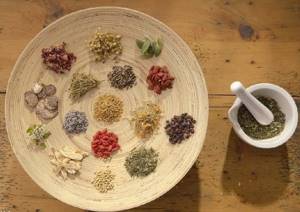
Theoretical foundations of physiology and pathology of Tibetan medicine
Important principles of the doctrine of Tibetan medicine are concentrated in the 2nd tantra of the Four Foundations treatise, namely the Explanatory Tantra, which was largely adopted from Ayurveda and supplemented by local cultural traditions, determined largely by Buddhist philosophy.
Tibet uses the concepts of all Asian medical systems, which are function medicine, energy medicine, since function is the result of energy.
Energy manifests itself in three main forms:
Five elements
The main position is the doctrine that any matter, living or non-living, is a combination of five elements, of which each element consists of the characteristics of the previous one and its own in the order they are listed:
Thus, ether or space consists exclusively of the quality of non-resistance. Wind adds movement to non-resistance. Fire consists of the two previous states and heat. Next on the list is water, which already contains four qualities, where fluidity is added to the previous three. And finally, earth is the most complex element, already containing five states, including additionally hardness.
Depending on the combinations of these basic elements, one or another type of matter is born.
The human body, including its mental and physical aspects, also consists of five elements, which, varying in quantity, make up 7 main types of tissues : clear juice produced due to the digestion of food, blood, muscle, fat, bone, marrow and seminal fluid.
These seven tissues make up the structure of the body, a certain somato-psychic ensemble, the functioning of which is ensured by the three energies of the body.
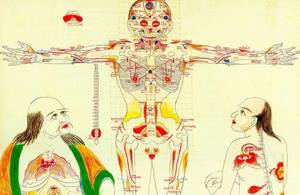
Three energies (states) of the body that determine the individual constitution:
Phlegm, mucus or "Bad Kan", consisting mainly of the water element with the addition of the earth element, provides hydration to the body and the mechanical functions of integrity, support, etc.
Bile, "Mkris pa", contains the element fire, and is responsible for heat processing in the body, starting with the process of digesting food and providing the entire chain of metabolic transformations for the production of body tissues. It is the opposite of phlegm in the Cold/Heat duality.
Organic wind or pneuma (from the Greek “breath, blow, spirit”) “Rlung”, consisting of the element wind, and reflecting its mobility and dynamics. This quality regulates kinetic functions and generates mental substance. Pneuma forms the third pole of the body, and is an intermediary between the functioning body and consciousness. Of all substances, only consciousness is the link between death and rebirth, since it persists after death.
Each of these three energies has its own characteristics : Phlegm - fatty, cold, heavy, tender, stable and sticky. Bile is oily, pungent, bitter, warm, light, laxative, fetid. Pneuma is tart, light, cold, thin, durable and mobile.
Cold and heat, which form qualities such as movement, density, connection, etc. inherent in the main energy of the body and the energy of the environment, for example, seasonal variations in climate.
These characteristics are also included in a longer list of qualities inherent in each material substance, formed as a result of various combinations of elements and energies. The most significant qualities are tastes and potentials; they determine the activity of energies according to the theoretical principle according to which each quality, increasing, produces more and more matter corresponding to it, and, on the contrary, reduces the opposite. It is this physical pattern, according to the treatises of Tibetan medicine, that underlies the influence of seasons, climatic conditions, as well as various biological effects (beneficial, harmful or healing) from lifestyle, nutrition or therapy on the body.
The described energy triad, maintained in a state of balance, individual for each person, ensures the optimal functioning of the human body, the moral and physical health of everything that makes up our universe. Conversely, the result of an imbalance of these three energies is disease, environmental and natural disasters, etc.
Pathological factors include not only excess or deficiency, but also the less detailed excitation of one of the energies in treatises.
According to Buddhist Tibetan philosophy, the root cause of any suffering is spiritual blindness, which in turn gives rise to three poisons of consciousness : – Desire/attachment, symbolized by the rooster, the root cause of wind diseases; – Hatred/Anger symbolized by the snake causes bile diseases; – Ignorance, symbolized by the pig, is the root cause of phlegm imbalance.
The Tibetan healer uses a variety of tools to restore balance to the body. But the main ones remain 4 important approaches (1) to treatment : – Prescribing a diet; – Changing the hygiene of life; – Medicines; – Other therapeutic procedures...
The Tibetan doctor considers it useless to use the last two approaches, that is, direct therapeutic agents, if the full potential of the first two is not used. According to Tibetan doctors, the main factors influencing the energy balance of the human body are food, lifestyle, seasons and evil spirits.
Principles of proper nutrition in Tibetan medicine
The five elements, the three energies of the body and the nature of cold and heat manifest in the various substances of our food in the form of taste, quality and potential. The potential of a biologically significant food element is determined by its energetic effect on the body.
Fundamental texts of Tibetan medicine explore the influence of food on the vital energies - bile, wind and mucus (phlegm) and explain the principles of interaction between nutrients (biologically significant elements of food) and the five constituents of matter.
The five elements manifest themselves through the variety of tastes . The difficulty is that there is no exact correspondence between taste and element. There are rather mixtures of different components with a dominant nuance. In fact, each taste contains a small part of each element, while one of the elements is dominant and gives the taste a very specific feature that characterizes it. For example, delicate taste comes from the elements Earth and Water, and is a derivative of these two elements. But at the same time, the delicate taste contains a little Wind and Fire, and of course Ether, which is included in all tastes. The basis of tastes, therefore, are the elements, namely: Earth brings the foundation, Water moisturizes, Fire warms, Wind brings movement and Ether - space.

As a result of the interaction of elements, 6 basic tastes are formed: – Earth + Water = delicate (sweet) taste; – Fire + Earth = sour; – Water + Fire = salty; – Water + Wind = bitter; – Fire + Wind = burning; – Earth + Wind = astringent.
The nature of the Earth element manifests itself in heaviness, density, oiliness, tenderness, oiliness and dryness. These are the potentials of the elements. The functions of the Earth's potentials give strength to the limbs, develop the body making it dense and cure diseases associated with the energy of the Rlung wind.
The nature of Water is fluidity, coldness, heaviness, oiliness, fatness and flexibility. Water moisturizes, softens the body, makes it dense and cures diseases associated with bile imbalance.
The nature of Fire manifests itself through warmth, pungency, dryness, rigidity, lightness and mobility. It increases body heat, stimulates maximum development of the body, improves skin color and cures Bad Kan phlegm diseases.
The nature of Wind is mobility, lightness, cold and hardness. It is neither oily nor dry. The nature of Wind strengthens joints, carries nutrients throughout the body and cures diseases of phlegm Bad Kan and bile Mkris pa.
Ether is found in everything, it is absorbed by all other elements and is part of all medicines. It cures diseases of all three energies.
The six tastes are usually distributed in the following order: mild, sour, salty, bitter, hot and astringent, since their healing effects are also considered in that order.
Taste is determined by the tongue : – Sweet (delicate) sticks to the tongue; – Sour irritates the teeth and wrinkles the face, it provokes copious secretion of saliva; – Salty produces heat and also causes profuse salivation; – Bitter taste clears bad odor and moisturizes the mouth; – The astringent taste sticks to the palate and gives a feeling of roughness.;
Healing properties originating from Fire and Wind have an ascending force, while those from Earth and Water have a descending force. In Tibet, medicine is considered not only and not so much as pills, but first of all, the selection of nutrients the body needs, depending on their potential.
Digestion
According to the texts, the root cause of every chronic disease lies in poor digestion. It is a fundamental function of any living organism. Do not forget that digestion is the most energy-intensive function of the body and exhausts the body.
Blood flows to the digestive organs, where all energy is directed to breaking down incoming products and transforming them into chemical particles suitable for absorption by the blood and assimilation by cells.
This entire process is regulated by digestive fire , and depends entirely on the balance of digestive thermoregulation.
According to the Tibetan tradition, tastes can influence the digestive fire and the entire physiology of digestion. When the digestive fire is dysfunctional, there is no ability to correctly recognize the characteristics of nutritional elements and tastes are distorted.
The criterion for the normal functioning of the digestive fire is the correct functioning of bile. The warmth of Wind and Mucus, the warmth of the body and secretions, the maintenance of health, energy, good appearance and longevity depend on it.
Bile separates what is needed and what is waste in ingested food, removes waste from the digestive zone, and also prevents undigested particles from entering the channels through which nutrients are transmitted.
With strong digestive fire, all nutrients flow from top to bottom, in a natural direction. If the fire cools down, digestion is insufficient, and food passes without nourishing the body, in vain, thereby weakening the most important functions of the body.
Basic flavor potentials
The taste of food is the key to good health. Those who have lost taste and appetite fall ill. Taste, digestion, appetite and health are interconnected and influence each other. The main rule of nutrition in the Tibetan tradition is the ecology of taste. It is necessary to limit yourself to only natural tastes, excluding all artificial products.
Sweet (delicate) taste
The functions of this taste are beneficial to the body, as they are nourishing, tonic and restorative. Sweets strengthen the body, prolong life in old age, stimulate the energy of children, and correct poor nutrition. Sweet taste regulates the imbalance of rlyung and mkris pa. However, excess sweets increase the amount of mucus and fat accumulation. Sweet taste cools the digestive fire and, as a result, slows down digestion. Moderate consumption of sweets improves mood and a feeling of comfort. Excesses provoke lethargy, laziness, drowsiness, and lead to obesity. For overly nervous people with a predominance of Wind, sweets have a positive effect, bringing calm and tranquility.
Sour taste
Increases digestive fire and body heat, stimulates appetite, corrects excess phlegm and improves digestion. By stimulating the internal secretion and flow of bile, sour at the beginning of a meal and in limited quantities helps with difficult digestion.
When applied externally, the acidic substance acts as a mild analgesic, blocking sensitivity and relieving wind stagnation. Excess acid stimulates the blood and bile, softening the body, disrupting vision, and also provokes dizziness, swelling and acne. Sour taste stimulates mental alertness.
Salty taste
Gives strength to the body, calms excess Wind, and clears blockages in energy channels, has a laxative effect and in large doses has an emetic effect. A warm salt compress provokes sweating, increases digestive fire and stimulates appetite. The salty taste eliminates the imbalance of the Wind. Excess salt leads to hair loss and graying, and tooth loss. Excessive salt consumption increases the number of wrinkles, leads to thirst, and provokes diseases of the blood and biliary tract. Salt retains water, leading to swelling, since the main characteristic of salt is moisture. Excess salt leads to high blood pressure and ulcers. Psychologically, salt leads to straightforwardness and sincerity, and in case of excess - rigidity and inertia.
Burning taste
It is warm and bitter, cures throat diseases, leprosy, laryngitis and pharyngitis. The pungent taste dries out wounds, enhances digestive fire and simplifies digestion. Stimulates appetite. The pungency burns fat, necrosis, reacts as a cleanser and opens the channels. The pungent taste is indicated in the treatment of Bad Kan mucus diseases caused by excess fluid, as it has the ability to dry out. A burning taste may be indicated in cases of rlung energy disturbances, provided that the dosage is moderate. The main role of the warm, burning taste is to cleanse and evacuate all stagnant impurities, for example in the intestines. It is a good anthelmintic. Excess burning burns fluids, can provoke joint deformation, pain in the lower back and back, and also increases redness, worsens the condition of burns, and dries out the skin and all mucous membranes.
Psychologically, the burning taste should be used very carefully.
The rapid onset of heat, and even fire, can result in excessive irritability and anger, aggressiveness and recklessness. In addition, the burning taste can provoke irresistible desires and, in particular, sexual desires.
Bitter taste
The bitterness is definitely cold and light. It is stable over time, cures anorexia, worms, thirst, leprosy, mucous and bilious vomiting, reduces body temperature in infectious diseases and is an antidote.
It dries out necrosis, fat, feces and urine. It cures diseases of the chest cavity and hoarseness. The bitter taste is indicated for the relief of bile disorders, and especially for the treatment of digestive disorders caused by excess of digestive fire. The bitter taste is an antipyretic, softens inflammation of various natures, external and internal. Bitterness also has bactericidal properties and eliminates fatty deposits and oils.
Excess bitterness burns the components of the body and increases the disturbances of Rlung and Bad Kan. At the same time, the body weakens and becomes exhausted. Indifference and dizziness appear. On a mental level, small doses of bitterness clarify the mind and ideas. Can stimulate visions of spiritual journeys and knowledge with their help of the real essence of things.
Astringent taste
Slightly cooling, can slow down digestion, has vasoconstrictor properties and slows down all body functions. In this regard, the astringent taste stops bleeding and stops diarrhea. The astringent taste increases Rlyung and suppresses Bad Kan and Mkris. Excess astringent taste, a rather rare occurrence, provokes paralysis, spasms and convulsions, complicating and blocking the circulation of energy.
On a psychological level, it can cause a desire for asceticism and simplicity.
An excess of astringent taste can lead to indifference, withdrawal from the world and even disgust towards everything that is in our sinful World.
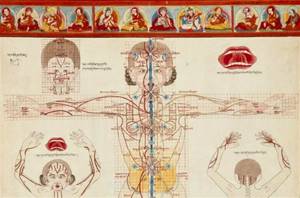
Thus, during the diagnostic process, the Tibetan doctor establishes the ratio of the main energies , and, depending on the diagnosis, prescribes a diet, complete with various tastes that act as medicines. In addition to the above methods, the treatment process may include herbal medicine, vacuum suction cups (medical cups), massage, effects on reflex zones and other healing methods. It must be emphasized that the main therapeutic method remains therapeutic nutrition and a healthy lifestyle.
As Tibetan doctors correctly say: “If a person eats right and follows the commandments of a healthy lifestyle... he does not need medicine. But if he doesn’t eat right... medicine won’t help him.”
Dr Namgual QUSAR, Jean-Claude SERGENT « Médecine tibetaine et alimentation » p.24
Prepared based on materials:
1. Dr Namgual QUSAR, Jean-Claude SERGENT “Médecine tibetaine et alimentation”
2. La médecine tibétaine: sources, concepts et pratique actuelle: actes de la journée du 8 avril 2006 à Metz (France) / [organisée par la Société française d'ethnopharmacologie; l'Institut européen d'écologie]; coordonné par Jacques Fleurentin et Jean-Pierre Nicolas
3. Forme et santé par la médecine tibétaine: un héritage pour notre temps / Marie-France Garaude-Pasty; 2009
Contraindications
The monks' diet has a small number of contraindications.
It is not recommended to use:
- For chronic diseases.
- During pregnancy and breastfeeding.
- Children and elderly people.
- Allergic reaction to components.
- Hypertension and some heart diseases.
- Diabetes.
- During high physical activity.
There are some disadvantages - it can be difficult to give up meat products in your diet, and muscle mass may begin to deplete. It is necessary to drink large amounts of water. A person does not always achieve the desired results without following clear rules.
Recommendations from nutritionists and how to go out correctly
The classic version of the diet is quite balanced and nutritious, it can be used for a long time.
When returning to your normal diet, add porridge and eggs; you can add poultry, rabbit, veal, and liver to the vegetable side dish.
Do not snack, do not eat before bed, drink more still water and exercise. Minimize the consumption of baked goods, fatty foods, and alcoholic beverages.
Reviews from doctors about the Tibetan method of losing weight are positive; this is a remedy that has virtually no contraindications, and at the same time acts carefully and effectively.
Nutritionists recommend eating more nuts and seeds; the diet contains few animal fats, and vegetable fats do not fully replace them. You should be aware of contraindications and strictly follow the advice.
The Tibetan diet is healthy, effective and harmless. Doctors approve and recommend trying it for yourself if you have problems with excess weight.
Fully or partially limited products
The proposed diet with notes of Asian cuisine and the spirit of Tibet is quite specific, but it is important that it is healthy and fairly balanced, therefore it prohibits a number of harmful foods:
- any carbonated drinks, especially sweet ones;
- alcohol and energy drinks;
- animal fats and meat;
- fish or any other canned food, sauces with a high content of preservatives, stabilizers, flavor enhancers and dyes;
- frozen products, semi-finished products;
- confectionery, sweets and sugar;
- pasta, dough, fresh white bread.
Table of prohibited products
| Proteins, g | Fats, g | Carbohydrates, g | Calories, kcal | |
Flour and pasta | ||||
| pasta | 10,4 | 1,1 | 69,7 | 337 |
| noodles | 12,0 | 3,7 | 60,1 | 322 |
| ravioli | 15,5 | 8,0 | 29,7 | 245 |
Confectionery | ||||
| jam | 0,3 | 0,2 | 63,0 | 263 |
| sunflower kozinak | 14,8 | 42,6 | 34,5 | 576 |
| candies | 4,3 | 19,8 | 67,5 | 453 |
| Raffaello candies | 9,3 | 47,8 | 38,8 | 623 |
| meringues | 2,6 | 20,8 | 60,5 | 440 |
| cookie | 7,5 | 11,8 | 74,9 | 417 |
| jam | 0,4 | 0,2 | 58,6 | 233 |
| gingerbread | 5,8 | 6,5 | 71,6 | 364 |
Chocolate | ||||
| chocolate | 5,4 | 35,3 | 56,5 | 544 |
| chocolate milkyway | 3,6 | 16,8 | 71,7 | 452 |
| twix chocolate | 5,0 | 25,0 | 63,0 | 496 |
Raw materials and seasonings | ||||
| ketchup | 1,8 | 1,0 | 22,2 | 93 |
| mayonnaise | 2,4 | 67,0 | 3,9 | 627 |
| sugar | 0,0 | 0,0 | 99,7 | 398 |
Meat products | ||||
| pork | 16,0 | 21,6 | 0,0 | 259 |
| fried beef | 32,7 | 28,1 | 0,0 | 384 |
| bacon | 23,0 | 45,0 | 0,0 | 500 |
| brawn | 12,6 | 32,0 | 0,5 | 336 |
Fish and seafood | ||||
| fish slice | 34,3 | 3,9 | 0,5 | 172 |
| canned fish | 17,5 | 2,0 | 0,0 | 88 |
| frozen fish sticks | 9,5 | 8,7 | 22,4 | 206 |
| salted herring | 19,8 | 15,4 | 0,0 | 217 |
| smoked mackerel | 20,7 | 15,5 | — | 221 |
| smoked tuna | 24,4 | 4,6 | 0,0 | 139 |
| smoked eel | 17,9 | 28,6 | — | 326 |
| sprats | 17,4 | 32,4 | 0,4 | 363 |
Oils and fats | ||||
| animal fat | 0,0 | 99,7 | 0,0 | 897 |
| rendered pork fat | 0,0 | 99,6 | 0,0 | 896 |
Alcoholic drinks | ||||
| vodka | 0,0 | 0,0 | 0,1 | 235 |
| cognac | 0,0 | 0,0 | 0,1 | 239 |
| beer | 0,3 | 0,0 | 4,6 | 42 |
| sake | 0,5 | 0,0 | 5,0 | 134 |
| cider | 0,2 | 0,3 | 28,9 | 117 |
Non-alcoholic drinks | ||||
| soda water | 0,0 | 0,0 | 0,0 | — |
| Pepsi | 0,0 | 0,0 | 8,7 | 38 |
| Fanta | 0,0 | 0,0 | 11,7 | 48 |
| energy drink | 0,0 | 0,0 | 11,3 | 45 |
| * data is per 100 g of product | ||||
Reviews
From most of the reviews taken, we can draw the following conclusion: - The diet should be applied in summer-autumn; in winter, food should consist of higher-calorie foods due to heat transfer. — The properties of rice to take potassium from the body, which means you need to include potassium-containing foods (pumpkin, parsley, dried apricots, prunes). — Necessary compliance with the drinking regime. In the morning on an empty stomach, a glass of clean water; after eating rice, you need to drink it three hours later, because the rice will already be able to absorb all the decomposition products in the gastrointestinal tract. — While eating, try to chew the rice thoroughly, this will have a positive effect on cleansing.
